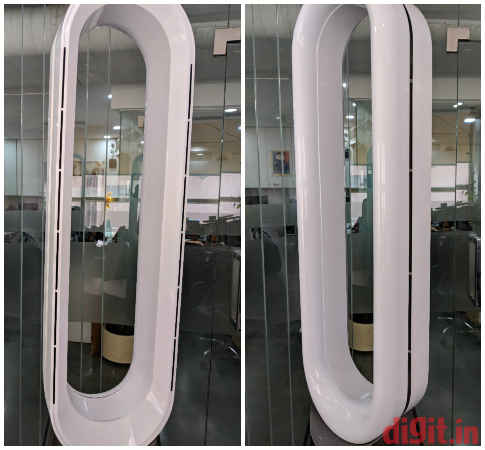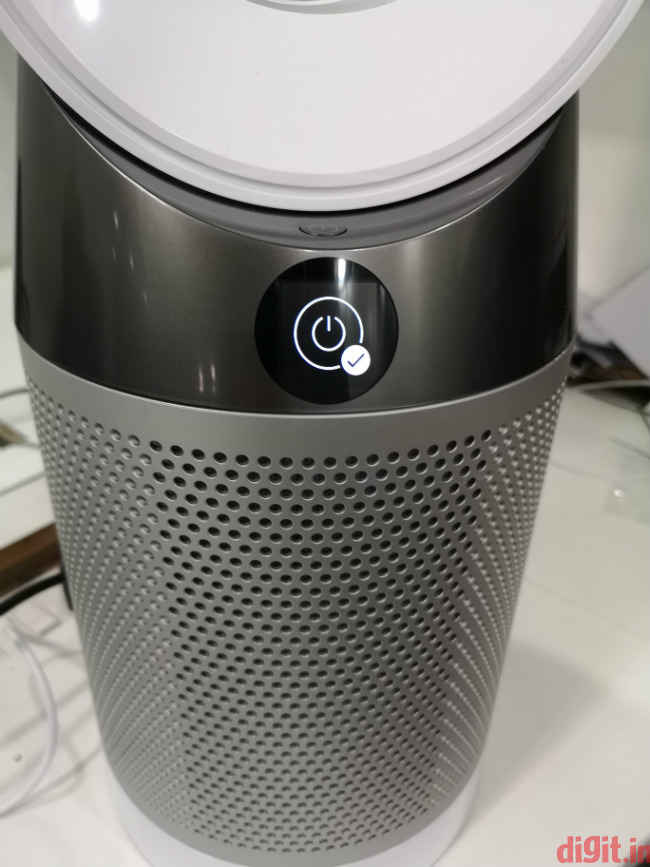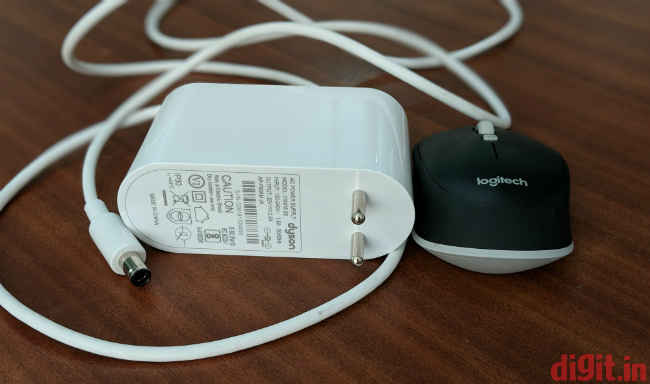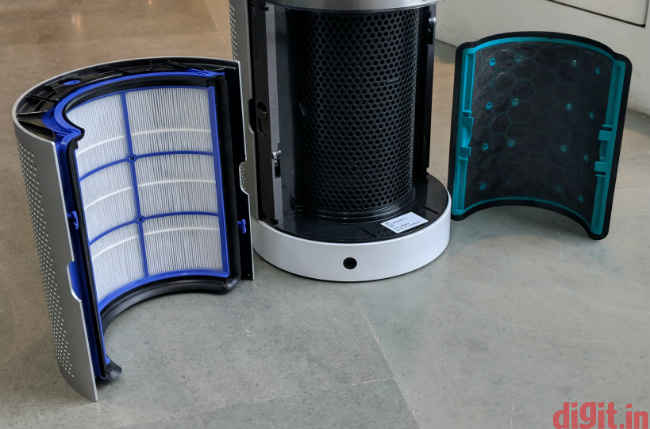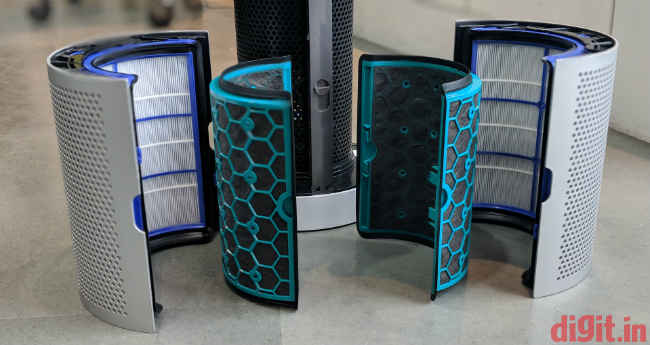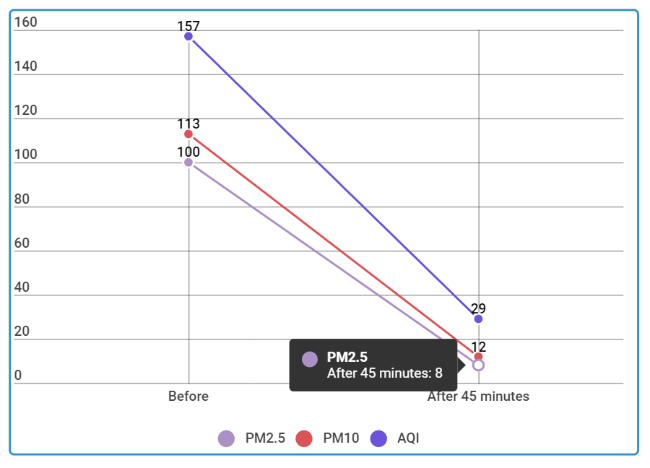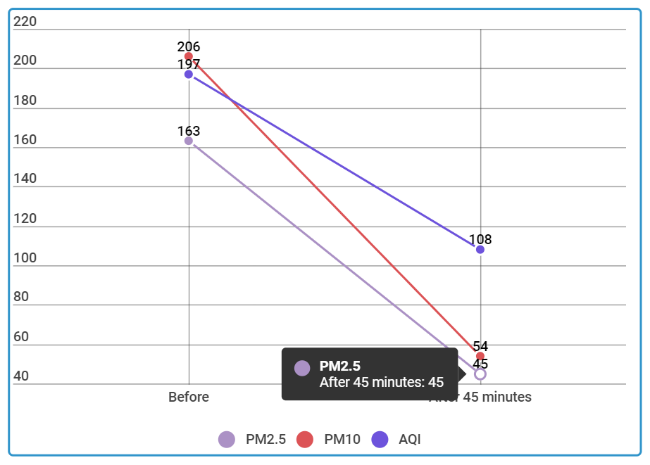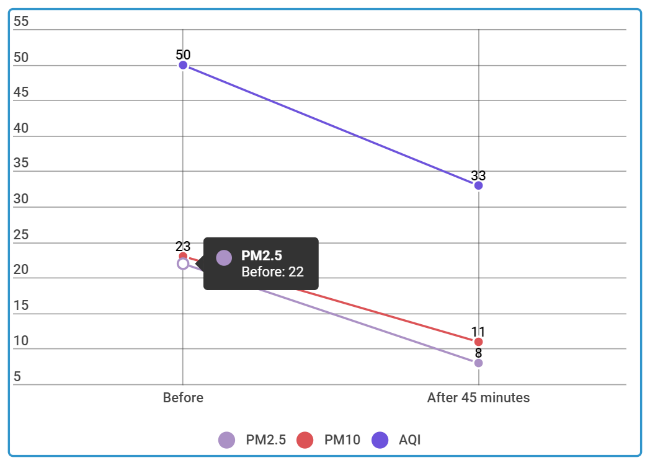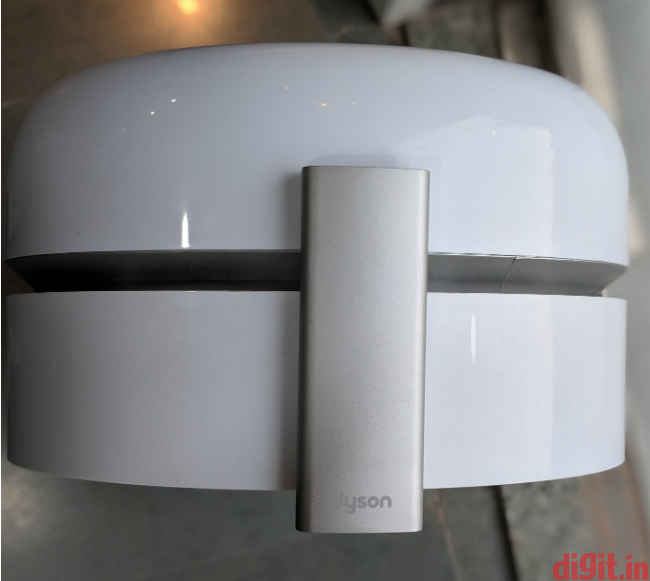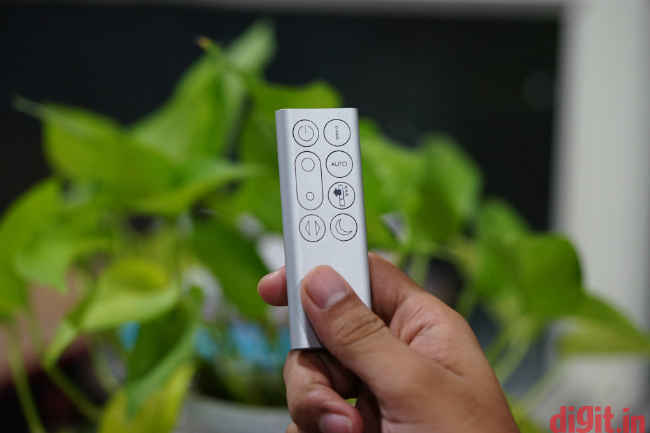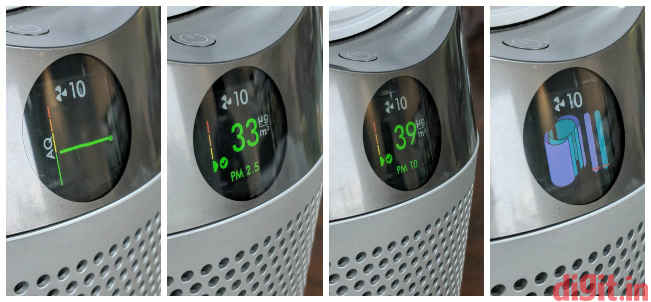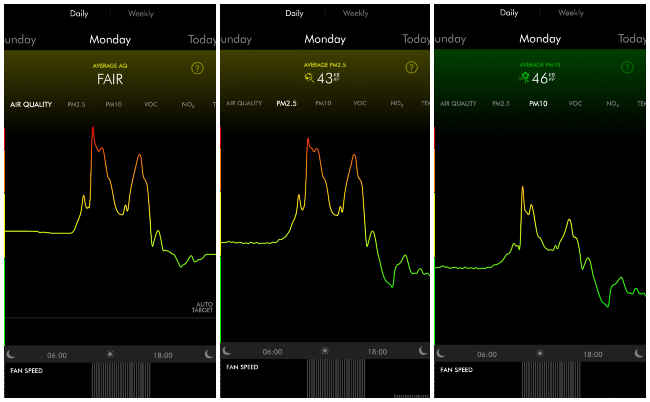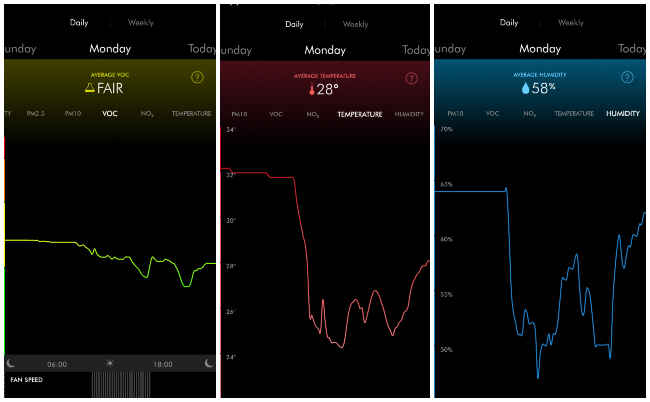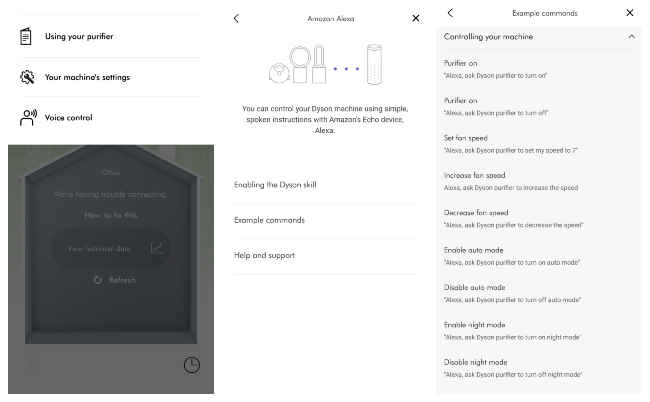Dyson Pure Cool Air Purifier Review : Good performance at a premium price tag
Packed with IoT features, voice commands, diffused air flow mode and more, the device is recommended for those who want a good looking, feature-rich air purifier that performs well when the IAQ is in moderate to a slightly higher range. However, as the Dyson Pure Cool costs Rs 43,900, it feels like instead of paying for cleaner indoor air, one might be shelling more for its unique design and the numerous features it ships with, which is not necessarily a bad thing depending on what ones' requirements are. Overall, the Dyson Pure Cool is a good air purifier that is worth a shot but due to its higher pricing, it might only appeal to a niche category of buyers in India.
Build and design
The design is where the Dyson Pure Cool air purifier truly excels as it borrows the same tried and tested design of its predecessor and improves upon it. Unfiltered air is sucked in from the base, where the fan is located and is passed through the filters in the process. The air is then forced out of the upper loop from a 1.5mm thin slit that hurls filtered air at a considerably greater speed, thus enabling the device to double up as a fan. Thanks to the company’s “Air Multiplier Technology,” the device can propel filtered air farther in a room. However, it should be noted that not all of the projected air is filtered as a vacuum is created around the outlet when filtered air is propelled out. Due to the design of the air purifier’s loop, the surrounding unclean air also rushes to fill the void.
Additionally, the Pure Cool comes with another aperture for operating in ‘Diffused Mode’ of air purification. This secondary slit is wider in size and is situated on the outer edge of the loop for directing, or rather diffusing, the filtered air into the room. The feature is certainly a welcomed one as it comes in handy when the ambient temperature is already low but the air indoors is polluted and filtration is required. In this mode, air is still blown out at the same rate and with the same efficiency but via the another slit so that one doesn’t feel too cold.
Dyson Pure Cool has two apertures to propagate air. The left image shows the front slit, while the right image shows the slit that is used when the device is being operated in diffused mode
Both, the cylindrical base from where the impure air is pulled in and the upper bladeless loop from where filtered air is directed out, are made of glossy ABS plastic, which is sturdy and exhibits good build quality. The air purifier takes up minimum space in a room and due to the unique design, it’s bound to get some attention. Previously, any information regarding the air quality of a room could be accessed only when the air purifier was linked with the Dyson app. However, the Pure Cool comes equipped with an LCD display so that the said information is easier to access. We will talk more about the new features the display adds to the device in the next section.
The Dyson Pure Cool air purifier's base from where the air is sucked in for filtering
The only somewhat irksome factor in the Dyson Pure Cool’s design is its brick-like power adapter. It is bulky and we were worried that an accidental drop might break it. The device’s predecessor came with a simple three pin plug that was hassle free but Dyson justifies the new power brick by saying that it can operate between voltage ratings of 100-240V as its developed for global markets. This is an added benefit as the device can handle slight voltage fluctuations. However, the company could have also tried to innovate on this front by keeping the functionality intact in some way but with a standard slim adapter that’s tailored for the Indian market.
Filters
The Dyson Pure Cool air purifier (TP04) comes equipped with two filters. The outer one is a HEPA filter made of glass borosilicate and the inner one is a tris activated carbon filter for odour and Volatile Organic Compound (VOC) removal. We have already come across this filter configuration while reviewing the TP03, but the length of material used in the HEPA filter has increased this time from 6.7m in the TP03 to 9m in the TP04, thus improving the efficiency. Dyson says that the outer HEPA filter on the TP04 is H-13 grade certified, which means that the filter grade is validated for use in hospitals and clean rooms with high requirements. These grade of filters should be capable of cleaning particles as small as 0.01 µm from the air.
After using the Pure Cool for over two weeks, we noticed that abundant dust gathered on the outermost HEPA filter. Its evident that the filter is doing its job but a layman would think that alongside replacement, the filters would need periodic cleaning. However, Dyson claims that there is no need of opening the filter section and cleaning it from the inside. Also, the filters are said to be in need of replacement when the Pure Cool air purifier is run for about 12 hours a day, for a year. We couldn’t really test this claim with the short amount of time we got to spend with the purifier and also because instead of showing filter life in hours, the Dyson app now shows it in percentage. However, both the filters’ life decreased by one percent after using the device for nearly eight hours every weekday, for almost a month at our office where air quality is good on an average. We got in touch with Dyson and the company said that the rated filter life is of around 4400 hours. This converts to around 183 days or approximately six months, but this can vary depending on how good or bad the air quality is inside your home.
HEPA filter latched onto the outer grill on the left and Carbon filter on the right
The density of activated carbon in the inner filter is also said to have increased three-fold for enhanced filtration of odour and Total Volatile Organic Compounds (TVOCs) like formaldehyde, benzene, and others. This should mean that in comparison with the TP03, the TP04 would be able to better remove odours from the air in lesser amount of time.
Unlike many other air purifiers, there is no additional pre-filter on the Pure Cool air purifier. It sports a mesh grill on the outside, inside which the two aforementioned filters are housed and installing them is also fairly easy. Both, the carbon filters and the HEPA filters come split in two parts and are conjoined when attached to the air purifier. Dyson says that the new filter design was essential for making an air purifier that is more efficient.
Unlike its predecessor, TP04’s base and the upper loop cannot be detached. The motor is still at the base and the carbon filter is first attached to the filter housing, followed by the HEPA filter. The HEPA filters are nested inside the outer mesh covering and they latched over the carbon filter. One good thing is that there is no ‘this way up’ rule to follow while installing the filters and there is no need of worrying that the filters are upside down. The entire process of installing the filer can take less than five minutes. Replacing any of the two filters will cost you Rs 1,900, which is the norm for all air purifiers in the same price range.
Performance
Dyson markets the Pure Cool as a device that performs three operations: sense, capture and project, which are necessary for an air purifier to perform efficiently. The company says that an air cleaning device should be able to sense the amount of indoor air pollution, capture the harmful particles efficiently and project the air inside a room so clean air is being circulated in all areas of a room. So, we set out to evaluate the performance and sensing capabilities of the device in this section. However, before we begin, we would like to explain and make you familiar with our air purifier testing procedures. We tested the Dyson Pure Cool in three different areas with varying size, ceiling heights and most importantly, differing air quality. The purpose of doing this is to provide you with a fair idea of how the air purifier will perform in dissimilar conditions so that one can cross-reference and assess how effective it might perform in their own home.
Room 1 is situated in a highly polluted area where air quality levels are most severe due to a nearby flyover with heavy traffic and construction work going on in close vicinity. It has an area of 120 sq ft with a ceiling height of 12 ft. Room 2 is in an area where pollution levels are generally moderate but it’s also regularly dusted and cleaned. Its ceiling height and area are 12 ft and 140 sq ft respectively. Room 3 is one of the conference rooms in our office, which has relatively lesser indoor pollution with potted plants kept inside. Its ceiling height is 12 ft and it has an area of 350 sq ft. Even though the Pure Cool features inbuilt sensors for displaying particulate levels, we also used two air quality monitors to independently ascertain whether it’s actually cleaning the air or not. One of the air quality monitors that we used was the AirVisual Pro air quality monitor for taking note of the Air Quality Indicator (AQI) reading. The reading is based on the amount of PM2.5 particles as the device is tuned per the Indian pollution standards, which are different from other countries.
In all the three rooms, we left the air purifier running for 45 minutes while logging the particulate levels (in µm/m3) on a regular basis. Prior to the commencement of air purification tests in room 1, the PM2.5, PM10 and the overall AQI readings were 100, 113 and 157 respectively. Do note that the lower the three readings are, the better the air quality could be. After running for 45 minutes, we took the readings again and the Dyson Cool Pure managed to bring the PM2.5 levels down to 8, PM10 to 12 and the overall AQI to 29. Considering how degraded the Indoor Air Quality (IAQ) was, the air purifier performed quite well.
Particulate readings and AQI graph for Room no 1
As mentioned above, we have mostly observed a moderate level of air pollution in the room 2, however, the level of pollutants was considerably lower this time around with PM2.5 and PM10 readings already down at 27 and 35 respectively. So, we introduced tobacco smoke from one cigarette into the room and as expected, the PM2.5 and PM10 levels almost immediately skyrocketed to 600 and 1000 respectively. So, now you know how dangerous smoking is even for someone who is not smoking but in close vicinity.
We waited 10 minutes before entering the room 2 as studies indicate a strong relationship between passive or second-hand smoke inhalation and heart diseases. By then, the PM2.5 levels dropped back to 163, PM10 to 206 and AQI was at 197. It should be noted that these levels are still well above the permissible limit in India of 40 µg/m3 of PM2.5 and 60 µg/m3 of PM10. In its 45 minute runtime, the Pure Cool was able to reduce the PM2.5 levels to 45, PM10 to 54 and the overall AQI to 108. Even though the air purifier’s performance has improved when compared with its predecessor, there is still room for improvement.
Particulate readings and AQI graph for Room no 2
The air quality was least degraded in the room 3 and these lowered numbers could actually make it difficult for an air purifier to drive them down further. However, the Dyson Pure Cool still managed to lower the PM2.5 particulates from 22 to 8, PM10 from 23 to 11 and the AQI from 50 to 33. The Dyson Pure Cool performs well in this case as one of the best air purifiers we tested also struggled when the air quality was already good.
Particulate readings and AQI graph for Room no 3
Coming to the air purifier’s sensing capabilities, it comes equipped with three sensors that enable the device to work on Auto mode. A laser-based particulate sensor keeps track of the PM2.5 and PM10 particles in the air, while a VOC sensor detects if there are harmful gases mixed with the air. There is also a sensor to measure the humidity and temperature inside a room. These three sensors work together and generate data that can be accessed either via the device’s LCD screen or the Dyson app. However, when the device is switched to auto mode, this sensor input is utilised to adjust the air purifier’s speed automatically, depending upon the amount of particulate matter detected in the air. We experienced that the sensors are fairly accurate as the air purifier went up directly when the auto mode was turned on.
Controls
The Dyson Pure Cool air purifier comes with an IR remote, which sports a minimalistic, clean design with fairly large and tactile buttons. It is simple to use and is almost similar to the one used on the Pure Cool Link, except for some additional buttons for using the new features. Same as its predecessor, the remote also magnetically attaches to the top of the air purifier’s loop and doesn’t slip off.
The remote enables standard functions of the air purifier like switching it on and off, adjusting its speed between one to ten, toggling the oscillation, night mode and diffused air purification feature. The oscillation mode allows one to choose from 45, 90, 180 and 350 degrees of rotation and switching the device to night mode dims the LCD screen and slows the fan speed. When switched to the auto mode, the Pure Cool makes use of the previously mentioned sensors onboard for detecting the current air quality and adjusting the device’s speed accordingly. It can take some time to get used to the air purifier’s unwarned whirring as it automatically jumps to the highest fan speed setting.
The Information button provides insights about the current air quality in a room on the device’s LCD screen. The display shows current and AQI levels over a 24 hour period in a graphical representation, and the VOC levels and NO2 levels are also displayed in the same manner. Exact values are only shown for the PM 2.5 and PM 10 particles. The air purifier’s internal sensors are fairly accurate but the particulate levels shown on the air purifier’s display once showed a considerable deviation from our readings. However, that could be an isolated case as the this didn’t happen again during our tests.
App Connectivity
Like its predecessor, the Pure Cool can also be paired with the Dyson app. This enables the device’s IoT capabilities. The device-app linking process is more streamlined and easier this time, thanks to Bluetooth assisted automated pairing. Once the linking process is done, the app boots up to show the indoor air quality, which is ranked from Good, Fair, Poor and Very Poor. An overview of the PM 10, VOC and NO2 pollutants is shown as well.
The app also enables scheduling so that one can set the air purifier to run overnight or only on some days, during specific hours. All functions of the remote are available in the app too, along with an additional feature of changing the direction which the air purifier faces. In the apps’ settings, there is an option to check the remaining filter life and as mentioned earlier, it’s shown in percentage instead of hours. Dyson can also push software updates for the air purifier via the app, meaning new features could be made available for it over time. There is also a ‘Continuous Sensing’ mode in settings, which when toggled on, keeps the air purifier running at very low speeds to log information over time.
The Dyson Pure Cool also supports voice control with Alexa enabled devices. However, the feature is yet to made available in India and the company says that it will be rolled out soon.
Bottomline
Dyson says that it pours enormous funds into the research of its products and the ingenuity stemming from the research is surely reflected in its Pure Cool air purifier. The device was designed keeping real-world functionalities in mind, to project and circulate clean air in every corner of a room, and it also performs well in its primary task of air purification. The new LCD display was a much-needed addition to the air purifier as a simple representation of how good or bad the Indoor Air Quality (IAQ) is can increase awareness in motivating one to take proper steps for mitigating the issue. The air purifier works well in moderate to slightly high pollution levels but as it is priced at Rs 43,900, it feels like instead of paying for cleaner indoor air, one might be shelling more for its unique design and the numerous features it ships with, which might not be a bad thing depending on what one wants. Overall, the Pure Cool is a good air purifier but due to its higher pricing, it might only appeal to a niche category of buyers in India.
There are also other cheaper options priced at around Rs 10,000 to select from, like the Mi Air Purifier 2 (review) or the Kent Alps (review). However, we did check the two devices’ performance and seeing how the pollution levels are on the rise, one might need to buy a couple of these air purifiers to clean the air in a large room of area between 350-500 sq ft, with a ceiling height of 12ft or 10ft. Contrarily, if money is not an issue, there is also the high-end IQAir HealthPro 250 (review) air purifier that manages to justify its hefty price tag of over Rs 1 lakh with excellent performance.
–With inputs from Adamya Sharma and Swapnil Mathur

